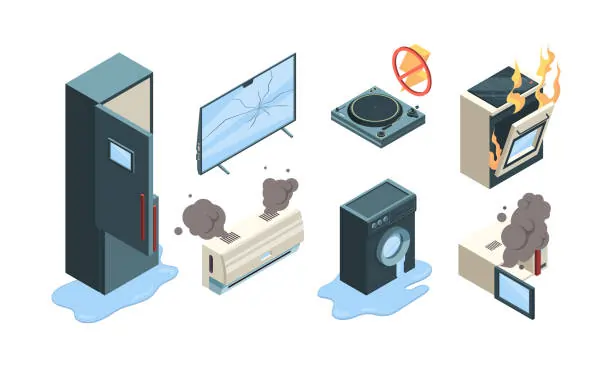How Temperature and Humidity Affect Appliance Parts
Introduction
Household appliances make life easier in every home by providing essential services, from preserving food to keeping our clothes clean. Yet, few homeowners realize that environmental factors, such as temperature and humidity, can dramatically affect these machines’ performance, efficiency, and longevity. Understanding these influences and taking proactive measures can help protect your investment and prevent unnecessary breakdowns. Whether you seek maintenance advice or genuine OEM replacement components from a trusted supplier like samsungparts.com, understanding how your environment impacts appliances is essential for smarter home care.
Awareness of these factors not only helps extend your devices’ lifespan but also minimizes energy costs and ensures optimal safety in your living space. With climate-related stresses increasingly common, knowing how and why changes in temperature and humidity cause wear and tear will put you ahead in preventing costly repairs.
Temperature’s Impact on Appliance Components
High Temperatures
Prolonged exposure to heat can wreak havoc on appliance parts and electronics. Many kitchen appliances, HVAC systems, and home entertainment devices rely on semiconductors and circuit boards sensitive to excess heat. High ambient temperatures shorten the lifespan of these components, may result in thermal expansion that loosens internal joins, and typically lead to unpredictable performance or outright failure. For example, excessively warm environments make refrigerators and air conditioners work harder, increasing the risk of premature compressor burnout.
Cold Temperatures
On the other end of the spectrum, cold can also pose risks to home appliances. Rubber seals and plastic hoses, commonly found in washing machines, dishwashers, and refrigerators, are especially susceptible to stiffening and cracking when subjected to lower temperatures. Furthermore, some appliances may have difficulty starting or performing efficiently if parts become brittle or electronics are affected by condensation from freezing and thawing cycles. That’s why manufacturers recommend keeping major appliances in environments where temperatures remain safe and stable.
Humidity’s Role in Appliance Performance
Humidity is another environmental variable that significantly impacts household machinery. High humidity promotes moisture accumulation inside and around electronics and metal components. Over time, this moisture can cause electrical short circuits, corrode connections, and erode sensitive appliance parts. For example, homes in coastal regions or climates with consistently high air moisture levels often see an uptick in malfunctioning microwaves and degraded washing machine drums.
Persistent dampness also fosters rapid mold and mildew growth. This is more than just a nuisance; in appliances like washing machines, dehumidifiers, and HVAC systems, unchecked moisture can seriously impede efficiency and create unwanted health hazards. According to Consumer Reports, homeowners in humid climates should take extra care by regularly inspecting appliance interiors and ensuring adequate airflow to mitigate these problems.
Effects on Refrigeration Appliances
Cold storage appliances like refrigerators and freezers are particularly vulnerable to environmental swings. In hot, humid conditions, these units expend more energy to maintain cool internal temperatures, causing greater wear on compressors and gaskets. When humidity levels soar, condensation can form inside the unit and on its coils, reducing cooling efficiency and increasing energy consumption. Over time, this extra strain may increase your energy bills and reduce your appliance’s longevity due to repeated cycling and shorter compressor life spans.
Additionally, improper ventilation in an enclosed kitchen or storage area compounds the issue, resulting in an excessive buildup of warm air around the back of appliances and causing components to overheat. Routine cleaning of condenser coils and keeping fridge and freezer locations well-ventilated are simple yet crucial steps to extend appliance life, as echoed in maintenance tips from Consumer Reports.
Impact on Laundry Appliances
Laundry rooms are typically moist, so washing machines and dryers are regularly exposed to fluctuating temperatures and humidity. High humidity extends drying cycles, reduces energy efficiency, and can cause lint to cake within vents, posing a potential fire risk. For washing machines, damp spaces encourage mold and mildew within drums, hatches, and detergent dispensers—especially when the door/gasket area is left sealed after washing.
Owners should pay attention to odors, signs of mold, and unusual humidity in laundry rooms. Using a dehumidifier and periodically airing out appliances by leaving doors open can drastically reduce risks. Regularly running a cleaning cycle with specialized tablets or diluted vinegar also helps eliminate build-up and bacterial growth.
Protecting Appliances from Environmental Factors
Homeowners can take several practical steps to prevent environmental conditions from hastening appliance breakdowns:
- Keep home temperatures between 60°F and 80°F to provide a safe operating environment.
- Use dehumidifiers or moisture absorbers in rooms with high humidity.
- Ensure good ventilation around all appliances, especially fridges, freezers, and laundry machines.
- Inspect hoses, seals, and vents frequently for signs of moisture or mold.
- Regularly clean filters, coils, and other exposed appliance parts as part of routine maintenance.
Additionally, always follow manufacturer guidelines for placement and storage—keeping large appliances away from windows, exterior doors, or sources of moisture whenever possible.
Final Thoughts
Temperature and humidity are sometimes-overlooked influences that profoundly affect household appliances. Fluctuations cause everything from cracked seals and rusted parts to malfunctioning electronics and lower efficiency. With vigilance, proper room climate control, and regular cleaning or maintenance—plus using reputable providers for OEM replacement parts—you can keep your appliances running smoothly for years to come.
Read more: Exploring the Benefits of Bakery Bags for Convenient and Eco-Conscious Packaging – SizeCrafter
Creative Ways to Transform Your Kitchen with Cabinet Refacing Services – SizeCrafter
Beyond Bonuses: Creative Recognition That Drives Engagement – SizeCrafter

